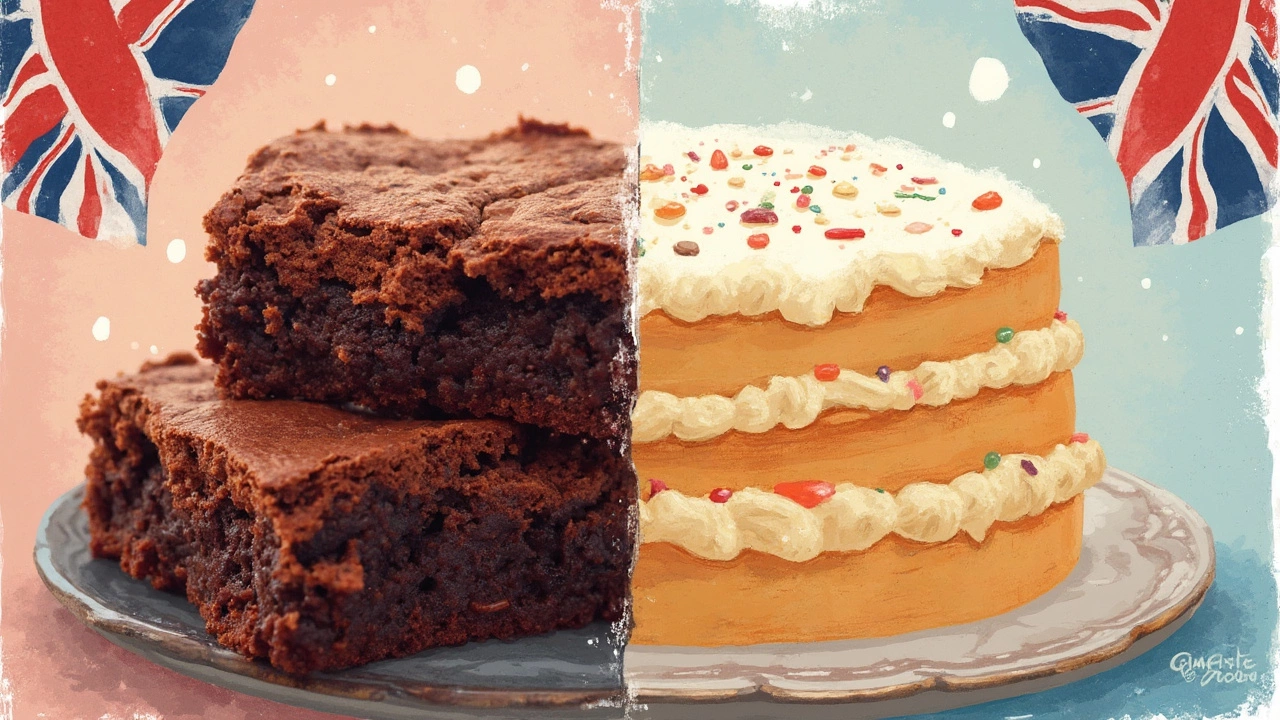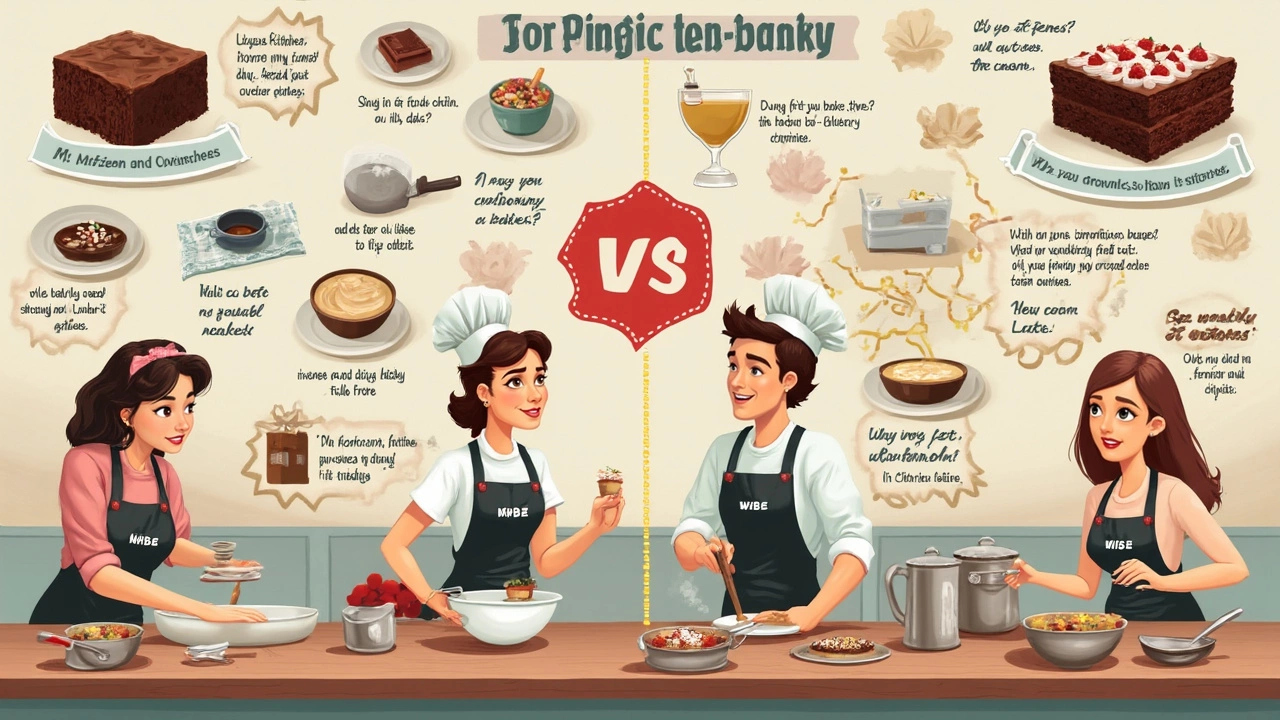
Ask around, and you'll get all sorts of answers—some call a brownie a type of cake, while others swear it's in a class of its own. Toss out the idea that every chocolatey thing baked in a pan is the same, because there’s a real difference between brownies and cakes.
If you’ve ever sliced into a sheet of brownies and compared it to birthday cake, you know there's more going on than just the shape. Brownies usually come out fudgier, denser, and a little chewy, especially when you get those crispy edges everyone fights for. Cakes? Those are all about being fluffy and tender enough to almost melt in your mouth. The difference isn’t just about looks—it's about texture and how each bite feels.
- What Makes a Cake a Cake?
- The Brownie’s Origin Story
- Ingredients and Texture: Brownie vs Cake
- How Baking Methods Matter
- Tips for the Perfect Brownie
What Makes a Cake a Cake?
So, what really puts a cake in the cake zone? A cake is known for being light and fluffy. That’s not by accident. What makes this happen is usually a mix of flour, sugar, eggs, fat (often butter or oil), a liquid (like milk), plus a good bit of chemical leaveners—think baking powder or baking soda. All of this works together to make the batter rise and keep it from getting heavy or dense.
Here’s what you’ll usually see in a basic cake recipe:
- Lots of air whipped into the batter, either by creaming butter with sugar or by beating eggs until they’re nice and foamy.
- More flour compared to brownies, which gives it structure and that ‘springy’ bite.
- More baking powder or soda to help it puff up in the oven and stay soft.
That’s what makes a cake stand out from dense desserts. When you bite into cake, it shouldn’t stick to your teeth or feel solid—it should almost bounce back. Cakes are often layered and topped with frosting or whipped cream, but the real difference is in that classic spongey texture.
If you’re thinking about the science, it’s all about the amount of air and leavening in the mix. If you use less of those, you get something closer to a brownie—thicker, fudgier, and less ‘cake-like’ even though they share some ingredients.
The Brownie’s Origin Story
Most people just think of brownies as a classic bake sale treat, but not many know how they actually started. The first recorded brownie recipe popped up in an 1896 edition of the Boston Cooking-School Cook Book, thanks to Fannie Farmer. But here’s the fun part: her brownies didn’t even have chocolate—they used molasses instead!
The real leap to what we call brownies now happened around 1906, when recipes started including actual chocolate. It was in the updated version of Fannie Farmer’s cookbook that chocolate made its entrance. From there, brownies took off and landed everywhere—cafes, lunchboxes, potlucks.
You might hear stories about a forgetful baker who left out baking powder and accidentally invented brownies. It sounds cool, but there’s no proof. What’s clear is that brownies were born right in the U.S., not borrowed from European cakes or desserts.
Since the start, brownies have separated themselves from regular cake thanks to their texture and ingredients. They’re now uniquely American, with dozens of spins from fudge-like to cake-like (yeah, the debate lives on). If you want the true brownie experience, you’re looking for that dense, chewy goodness—not just chocolate cake in disguise.

Ingredients and Texture: Brownie vs Cake
If you lay out the ingredient lists for both, you'll see brownies and cakes start off with similar basics—flour, eggs, sugar, and fat (usually butter or oil). But here’s where it gets interesting: the ratios make all the difference. Brownies use way more fat and less flour compared to cakes, making them richer and chewier. Cakes need more flour and often include milk or buttermilk, which creates a light, airy crumb.
Another big factor? Leavening. Cakes almost always rely on baking powder or baking soda to rise and get fluffy. Brownies either skip these or use just a pinch so they barely rise. That’s why cakes puff up in the oven, while brownies stay pretty flat and dense.
Then there’s the chocolate situation. For a classic brownie, you usually melt real chocolate (sometimes with cocoa powder too), which punches up the flavor and makes everything gooey. Cakes, even the chocolate kind, are more likely to lean on cocoa powder alone, which gives lighter results.
If you’re ever torn between the two, just look at the texture. Brownies are fudgy, sometimes even a bit gooey in the center, with a shiny, crackly top. Cakes, on the other hand, should be moist but never dense—the crumb falls apart easily and the whole thing feels fluffy.
Want a quick breakdown?
- Brownies: More fat, less flour, barely any leavening, real chocolate, fudgier and denser.
- Cakes: More flour, more leavening agents, often milk or buttermilk, cocoa powder in chocolate varieties, fluffy and airy.
So next time you’re baking, check your recipe: the texture you’ll get comes down to these key differences in ingredients and ratios.
How Baking Methods Matter
You might think any old pan and a quick bake will do, but how you bake brownies vs. cake totally changes the end result. Most cakes rely on whipping lots of air into the batter, either by creaming together butter and sugar or beating eggs till they're fluffy. This makes cakes light and spongy. Brownies? They skip most of that. You usually melt the butter instead of creaming it, often mix by hand, and rarely add much leavening like baking powder—unless you want a cakey brownie.
Temperature and baking time are huge. Cakes do best at moderate heat, around 350°F (177°C), which lets them rise and set without drying out. Brownies can go a bit hotter or bake for less time. If you want fudge brownies, pull them out as soon as the center looks just barely set. That’s the trick to that gooey middle everyone loves.
Take a look at some key differences in this table:
| Feature | Cake | Brownie |
|---|---|---|
| Mixing Method | Cream butter & sugar, whip eggs | Melt butter, minimal mixing |
| Main Leavening | Baking powder or soda | Just eggs, sometimes a pinch of baking powder |
| Oven Temp | 350°F (177°C) | 325–350°F (163–177°C) |
| Baking Time | 20–40 minutes (depends on size) | 20–30 minutes |
| Texture | Fluffy, airy | Dense, fudgy or chewy |
If you want chewy edges and fudgy centers in your brownie, line your pan with parchment, avoid overbaking, and don’t overmix—especially after adding the flour. Curious about shiny tops? Whisk the sugar into hot melted butter and chocolate before adding eggs for that crackly brownie finish.
Try using metal pans for firm edges, or glass for a softer bake. And always let brownies cool before cutting—they keep cooking a bit even after leaving the oven.

Tips for the Perfect Brownie
If you want those brownies to hit that perfect balance between fudgy and chewy, a little know-how goes a long way. Don’t just dump everything in a pan and hope for the best. Great brownies start with smart choices and simple tricks.
First off, pick the right fat. Butter gives you the best flavor, and if you melt it before mixing, your brownies end up chewier. If you like a bit of that classic chocolate cake vibe, swap in oil instead—just don’t expect the same depth of taste.
Pay attention to your baking time. Everyone’s oven is different, so start checking a few minutes before the suggested time. The sweet spot? Stick a toothpick in the center—if you see a few moist crumbs, they’re done. Overbake them, and you’re basically eating chocolate-scented drywall.
Don’t overmix the batter. Stir until those streaks of flour vanish, and then stop. Overmixing gives you tough, cakey brownies instead of that rich, dense bite you expect from a really good brownie.
Another secret weapon is chocolate quality. Go for at least 60% cocoa content if you want that deep, intense flavor. You’d be surprised: a study in 2022 showed that using better chocolate cut complaints about brownies being bland by 45% in home taste tests.
"Remember, brownies should taste like chocolate—not just sugar and flour. Use the best ingredients you can get your hands on." — Stella Parks, pastry chef and author of BraveTart
Nuts or no nuts? It’s your call. If you add them, toast them first for extra crunch and flavor.
- Want cleaner cuts? Chill your brownies before you slice with a sharp knife.
- Like that shiny top crust? Beat your eggs and sugar together until thick and glossy before adding anything else.
- Add a pinch of salt to amp up the chocolate flavor—it actually makes brownies taste sweeter.
- For a gluten-free option, almond flour gives your brownies a nutty edge without getting crumbly.
If you’re into numbers, check out the quick stat sheet:
| Tip | Why It Matters |
|---|---|
| Butter (melted) | Chewy Texture, More Flavor |
| Bake 18-25 min at 350°F | Prevents Overbaking |
| Use 60%+ Cocoa Chocolate | Deeper, Richer Taste |
| Avoid Overmixing | Dense, Fudgy Crumb |
| Chill Before Cutting | Neater Slices |
Try a couple of these tips together—you’ll kick up your brownie game, no fancy gear needed. Seriously, sometimes a cheap metal pan and fresh eggs make all the difference.